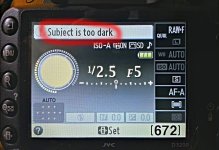Today I was challenged with a difficult situation (to me). I had my camera on my desk and my co-worker asked me to take a photo of her.
She's African-American with a dark skin tone. She stood infront of a bright window and smiled. The camera hunted and struggled to find her face. 3 seconds of awkward 80-200 ED AF-D mechanical whizzing. I focused on the closest bright article of clothing to her face, her grey hat. I snapped once and she walked over before I could change the settings and try again. Her face was underexposed liked a shadow. I botched it. I was embarrassed.
What's your tip for getting the correct exposure for multiple or dark skin tones? Assuming natural lighting.
Here are my camera settings for my D750:
- I shot in (U2) Manual, F/2.8, 1/200th SS, and Auto-Iso
- AF-C, 3-D (single point, with grouping)
- Metering [ (o) ] <- That's my best way to describe it.
Possible solutions?
- How can I quickly adjust my Exposure Compensation?
- Can I change my Metering to detect on my focus point? I don't think this one would've worked anyway because I focused on her hat. The image was exposed for the hat.
- Other possible solutions?
She's African-American with a dark skin tone. She stood infront of a bright window and smiled. The camera hunted and struggled to find her face. 3 seconds of awkward 80-200 ED AF-D mechanical whizzing. I focused on the closest bright article of clothing to her face, her grey hat. I snapped once and she walked over before I could change the settings and try again. Her face was underexposed liked a shadow. I botched it. I was embarrassed.
What's your tip for getting the correct exposure for multiple or dark skin tones? Assuming natural lighting.
Here are my camera settings for my D750:
- I shot in (U2) Manual, F/2.8, 1/200th SS, and Auto-Iso
- AF-C, 3-D (single point, with grouping)
- Metering [ (o) ] <- That's my best way to describe it.
Possible solutions?
- How can I quickly adjust my Exposure Compensation?
- Can I change my Metering to detect on my focus point? I don't think this one would've worked anyway because I focused on her hat. The image was exposed for the hat.
- Other possible solutions?
Last edited:

